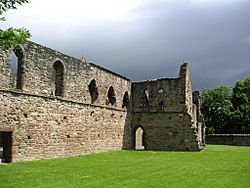Beauly Priory facts for kids
 |
|
| Monastery information | |
|---|---|
| Order | Valliscaulian, Cistercian (after 1510) |
| Established | 1230 |
| Disestablished | 1634 |
| Mother house | Val-des-Choux |
| Diocese | Diocese of Moray |
| Controlled churches | Abertarff; Comar; Conveth |
| People | |
| Founder(s) | Alexander II of Scotland John Byset |
| Important associated figures | Robert Reid |
Beauly Priory is an old religious building in Beauly, Inverness-shire, Scotland. It was once a home for monks. The priory was likely started around the year 1230. It's not completely clear who founded it. Some say it was Alexander II of Scotland, while others say it was John Byset. Some sources even say both helped to found it.
The monks who lived here were from France. Along with John Byset, who was a local landowner, they spoke a lot of French. This is how the area and the nearby river got their name. "Beau lieu" means "beautiful place" in French. This name then became "Beauly" in English.
There's also a local story about how Beauly got its name. People say that Mary, Queen of Scots was traveling through the area. She might have been on her way to Dingwall when she was a teenager. The story goes that she looked out of her carriage window and said, "Beau Lieu!" meaning "Beautiful place!"
Contents
The Priory's History
Beauly Priory was first home to a group of monks called the Valliscaulian order. This group was quite small and not well-known. Not many of the early leaders, called priors, are known by name.
Later, in 1510, the priory changed. It became part of the Cistercian order of monks. This happened after the Pope decided to close down the Valliscaulian order. Over time, the priory became less religious and more controlled by other people. These people were called "commendatory abbots."
Finally, in 1634, the priory's lands were given to the Bishop of Ross. This was done by a special royal paper. Today, the priory is mostly in ruins. But these ruins are still very large and interesting to see. They are a popular place for visitors in Inverness-shire. The site is also protected as a scheduled monument, which means it's an important historical place.
Famous Visitor: John Keats
In August 1818, a famous poet named John Keats visited Beauly. He was traveling with his friend, Charles Brown. They stopped at Beauly on their way to another town called Cromarty.
Their visit inspired them to write a poem together. It was called On Some Skulls in Beauley Abbey, near Inverness. Most of the poem was written by Charles Brown. But John Keats wrote the first line and the first few words of the second line. He also wrote three full parts of the poem.
Important People Buried Here
Many important people from Scottish history were buried at Beauly Priory.
- Hugh Fraser, 3rd Lord Lovat was buried here. He died in 1544 during a battle called the Battle of the Shirts.
- Kenneth Mackenzie, 7th of Kintail was buried at Beauly Priory after he died in 1492. His tomb is still there today.
- John Mackenzie, 9th of Kintail died in 1561. He was buried in the Mackenzie family's special area at Beauly.
- Kenneth Mackenzie, 10th of Kintail died in 1568. He had fought in the Battle of Langside just a few weeks before. He was also buried in the Mackenzie family's area.
- Colin Cam Mackenzie, 11th of Kintail died in 1594 at Redcastle. He was buried at Beauly as well.
- Walter Ross, whose father was a leader in Tain, was buried at Beauly Priory. He died from injuries he got in the Battle of Glen Affric in 1721.
Gallery
See also
 In Spanish: Priorato de Beauly para niños
In Spanish: Priorato de Beauly para niños





